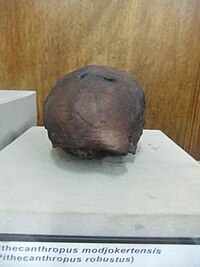Meganthropus paleojavanicus
|
Meganthropus Homo erectus palaeojavanicus Temporal range: |
|
|---|---|
 |
|
| Pithecanthropus robustus, Sangiran Museum, Sragen, Indonesia | |
|
Fossil
|
|
| Scientific classification | |
| Kingdom: | Animalia |
| Phylum: | Chordata |
| Class: | Mammalia |
| Order: | Primates |
| Family: | Hominidae |
| Genus: | Homo? |
| Species: | †H. erectus? |
| Subspecies: | †H. e. palaeojavanicus? |
| Trinomial name | |
|
Homo erectus palaeojavanicus? |
|
Meganthropus is a name commonly given to several large jaw and skull fragments found at the Sangiran site near Surakarta in Central Java, Indonesia. The original scientific name was Meganthropus palaeojavanicus, and while it is commonly considered invalid today, the genus name has survived as something of an informal nickname for the fossils.
As of 2005, the taxonomy and phylogeny for the specimens are still uncertain, although most paleoanthropologists consider them related to Homo erectus in some way. However, the names Homo palaeojavanicus and even Australopithecus palaeojavanicus are sometimes used as well, indicating the classification uncertainty. Of particular interest is that the finds were sometimes regarded as those of giants, although that is unsubstantiated.
After the discovery of a robust skull in Swartkrans in 1948 (SK48), the name Meganthropus africanus was briefly applied. However, that specimen is now formally known as Paranthropus robustus and the earlier name is a junior synonym.
Some of these finds were accompanied by evidence of tool use similar to that of Homo erectus. This is the reason Meganthropus is often linked with that species as H. e. palaeojavanicus.
The number of fossil finds has been relatively small, and it is a distinct possibility that they are a paraphyletic assemblage. Due to this, they will be discussed in detail separately.
This large jaw fragment was first found in 1941 by von Koenigswald. Koenigswald was captured by the Japanese in World War II, but managed to send a cast of the jaw to Franz Weidenreich. Weidenreich described and named the specimen in 1945, and was struck by its size, as it was the largest hominid jaw then known. The jaw was roughly the same height as a gorilla's, but had a different form. Whereas in anthropoids the mandible (=jaw) has its greatest height at the symphysis, that is, where the two rami of the lower jaw meet, this is not the case in Sangiran 6, where the greatest height is seen at about the position of the first molar (M1).
...
Wikipedia
